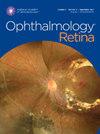Association between Age-Related Macular Degeneration and Mortality in a High Cardiovascular Risk Cohort
IF 5.7
Q1 OPHTHALMOLOGY
引用次数: 0
Abstract
Objective
To investigate whether age-related macular degeneration (AMD) predicts the risk of all-cause and cardiovascular disease (CVD) mortality in a high CVD risk cohort.
Design
Prospective cohort study.
Participants
A total of 1545 adult participants who presented to a tertiary Australian hospital for evaluation of acute coronary syndrome were included in this study.
Methods
Participants were evaluated for acute coronary syndrome using coronary angiography. Participants were concurrently examined for AMD from mydriatic fundus photographs, which were graded using the Wisconsin grading system into categories of any AMD, early AMD, and late AMD. Coronary artery disease was graded from coronary angiograms using the Gensini score. Mortality data were obtained 9 years after baseline examination through data linkage with the Australian National Death Index. Hazard ratios (HRs) were obtained using Cox regression analysis.
Main Outcome Measures
All-cause and CVD mortality data were obtained through data linkage with the Australian National Death Index. Death rates through June 2018 were compared by demographics and potential confounders.
Results
Any AMD was identified in 107 (6.9%) participants, including those with early (n = 86) and late AMD (n = 21). Over 9 years of follow-up, 234 (15.1%) participants had died, including 174 (11.3%) participants from fatal CVD events. After controlling for age, sex, body mass index, total cholesterol, smoking status, history of diabetes, hypertension, myocardial infarction, stroke, and macrovascular coronary artery disease severity using the Gensini score, there was an increased rate of all-cause mortality for those with any AMD (HR, 2.37; 95% confidence interval [CI], 1.54–3.64), early AMD (HR, 2.42; 95% CI, 1.48–3.94), and late AMD (HR, 2.25; 95% CI, 1.08–4.71). Any AMD (HR, 2.62; 95% CI, 1.61–4.26) and early AMD (HR, 2.61; 95% CI, 1.50–4.64) were also associated with a greater likelihood of CVD mortality. Late AMD was not associated with CVD mortality.
Conclusions
In individuals with high CVD risk, the presence of AMD at any stage independently predicted increased all-cause mortality. Meanwhile, any AMD and early AMD increased the risk of CVD mortality. Although mechanisms are unclear, this potentially reflects shared pathways between AMD and CVD.
Financial Disclosure(s)
The authors have no proprietary or commercial interest in any materials discussed in this article.
在心血管高危人群中,年龄相关性黄斑变性与死亡率的关系:一项前瞻性队列研究。
目的:研究老年性黄斑变性(AMD)是否可预测心血管疾病(CVD)高风险人群的全因和心血管疾病(CVD)死亡风险。方法:采用冠状动脉造影术对参与者进行急性冠状动脉综合征评估。同时,根据眼底照片检查老年性视网膜病变,采用威斯康星分级系统将老年性视网膜病变分为任何老年性视网膜病变、早期老年性视网膜病变和晚期老年性视网膜病变。冠状动脉疾病(CAD)则根据冠状动脉造影检查结果,采用詹西尼评分法进行分级。通过与澳大利亚国家死亡指数的数据连接,获得了基线检查9年后的死亡率数据。主要结果测量指标:全因死亡率和心血管疾病死亡率数据通过与澳大利亚国家死亡指数的数据链接获得。通过人口统计学和潜在混杂因素对截至 2018 年 6 月的死亡率进行了比较:- 107名参与者(6.9%)发现患有任何AMD,其中包括早期AMD患者(86人)和晚期AMD患者(21人)。在9年的随访过程中,有234人(15.1%)死亡,其中174人(11.3%)死于致命的心血管疾病。在对年龄、性别、体重指数、总胆固醇、吸烟状况、糖尿病史、高血压、心肌梗死、中风和使用 Gensini 评分的大血管 CAD 严重程度进行控制后,任何 AMD 患者(危险比 [HR] 2.37,[95% CI:1.54-3.64])、早期 AMD 患者(HR 2.42 [1.48-3.94])和晚期 AMD 患者(HR 2.25 [1.08-4.71])的全因死亡率均有所增加。任何AMD(HR 2.62 [1.61-4.26])和早期AMD(HR 2.61 [1.50-4.64])也与心血管疾病死亡的可能性增加有关。晚期AMD与心血管疾病死亡率无关:- 结论:在心血管疾病高风险人群中,任何阶段的老年黄斑变性都可独立预测全因死亡率的增加。结论:在心血管疾病高危人群中,任何阶段的老年黄斑变性都可独立预测全因死亡率的增加。虽然机制尚不清楚,但这可能反映了AMD和心血管疾病之间的共同途径。
本文章由计算机程序翻译,如有差异,请以英文原文为准。
求助全文
约1分钟内获得全文
求助全文

 求助内容:
求助内容: 应助结果提醒方式:
应助结果提醒方式:


